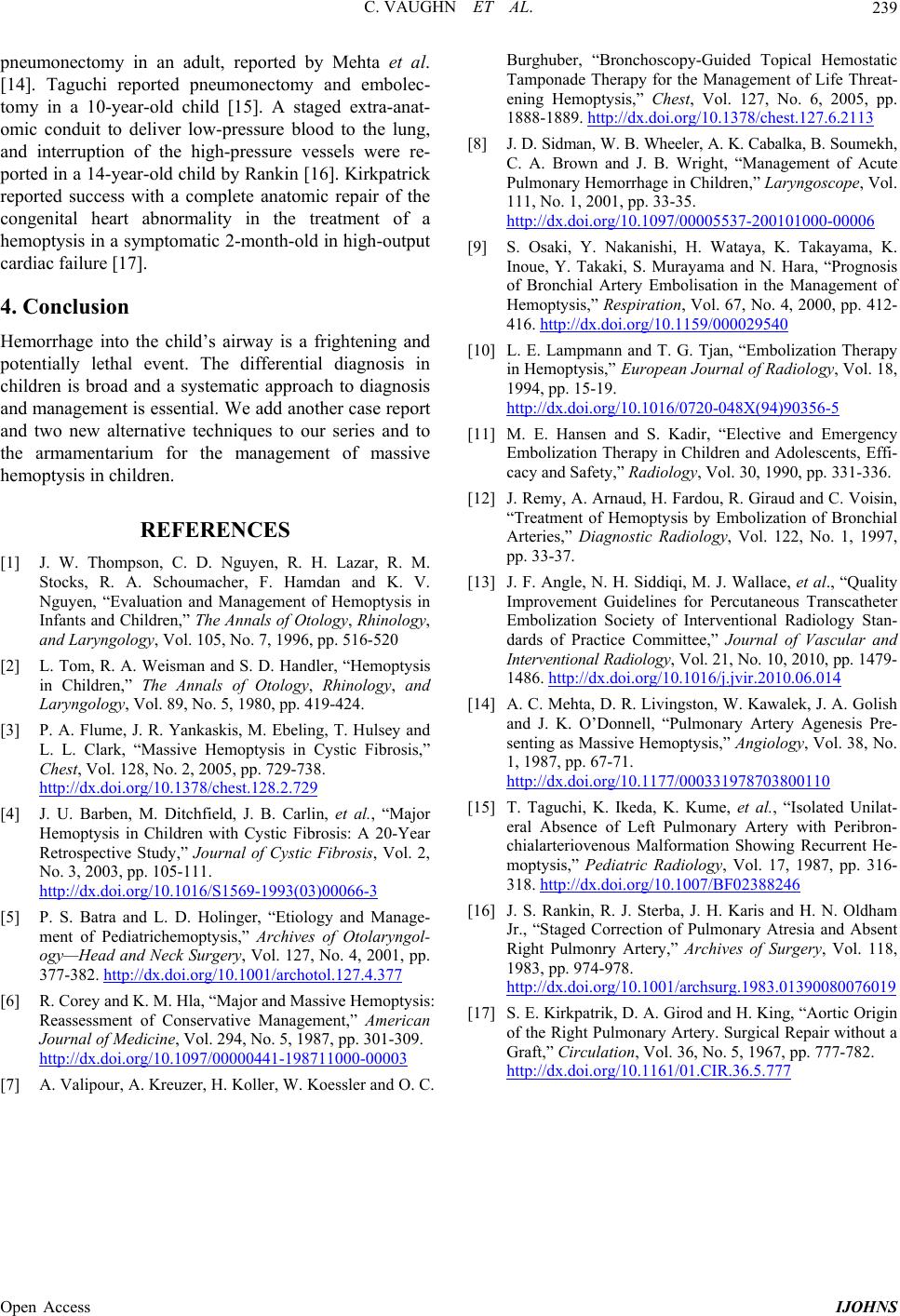
C. VAUGHN ET AL.
Open Access IJOHNS
239
pneumonectomy in an adult, reported by Mehta et al.
[14]. Taguchi reported pneumonectomy and embolec-
tomy in a 10-year-old child [15]. A staged extra-anat-
omic conduit to deliver low-pressure blood to the lung,
and interruption of the high-pressure vessels were re-
ported in a 14-year-old child by Rankin [16]. Kirkpatrick
reported success with a complete anatomic repair of the
congenital heart abnormality in the treatment of a
hemoptysis in a symptomatic 2-month-old in high-output
cardiac failure [17].
4. Conclusion
Hemorrhage into the child’s airway is a frightening and
potentially lethal event. The differential diagnosis in
children is broad and a systematic approach to diagnosis
and management is essential. We add another case report
and two new alternative techniques to our series and to
the armamentarium for the management of massive
hemoptysis in children.
REFERENCES
[1] J. W. Thompson, C. D. Nguyen, R. H. Lazar, R. M.
Stocks, R. A. Schoumacher, F. Hamdan and K. V.
Nguyen, “Evaluation and Management of Hemoptysis in
Infants and Children,” The Annals of Otology, Rhinology,
and Laryngology, Vol. 105, No. 7, 1996, pp. 516-520
[2] L. Tom, R. A. Weisman and S. D. Handler, “Hemoptysis
in Children,” The Annals of Otology, Rhinology, and
Laryngology, Vol. 89, No. 5, 1980, pp. 419-424.
[3] P. A. Flume, J. R. Yankaskis, M. Ebeling, T. Hulsey and
L. L. Clark, “Massive Hemoptysis in Cystic Fibrosis,”
Chest, Vol. 128, No. 2, 2005, pp. 729-738.
http://dx.doi.org/10.1378/chest.128.2.729
[4] J. U. Barben, M. Ditchfield, J. B. Carlin, et al., “Major
Hemoptysis in Children with Cystic Fibrosis: A 20-Year
Retrospective Study,” Journal of Cystic Fibrosis, Vol. 2,
No. 3, 2003, pp. 105-111.
http://dx.doi.org/10.1016/S1569-1993(03)00066-3
[5] P. S. Batra and L. D. Holinger, “Etiology and Manage-
ment of Pediatrichemoptysis,” Archives of Otolaryngol-
ogy—Head and Neck Surgery, Vol. 127, No. 4, 2001, pp.
377-382. http://dx.doi.org/10.1001/archotol.127.4.377
[6] R. Corey and K. M. Hla, “Major and Massive Hemoptysis:
Reassessment of Conservative Management,” American
Journal of Medicine, Vol. 294, No. 5, 1987, pp. 301-309.
http://dx.doi.org/10.1097/00000441-198711000-00003
[7] A. Valipour, A. Kreuzer, H. Koller, W. Koessler and O. C.
Burghuber, “Bronchoscopy-Guided Topical Hemostatic
Tamponade Therapy for the Management of Life Threat-
ening Hemoptysis,” Chest, Vol. 127, No. 6, 2005, pp.
1888-1889. http://dx.doi.org/10.1378/chest.127.6.2113
[8] J. D. Sidman, W. B. Wheeler, A. K. Cabalka, B. Sou me k h ,
C. A. Brown and J. B. Wright, “Management of Acute
Pulmonary Hemorrhage in Children,” Laryngoscope, Vol.
111, No. 1, 2001, pp. 33-35.
http://dx.doi.org/10.1097/00005537-200101000-00006
[9] S. Osaki, Y. Nakanishi, H. Wataya, K. Takayama, K.
Inoue, Y. Takaki, S. Murayama and N. Hara, “Prognosis
of Bronchial Artery Embolisation in the Management of
Hemoptysis,” Respiration, Vol. 67, No. 4, 2000, pp. 412-
416. http://dx.doi.org/10.1159/000029540
[10] L. E. Lampmann and T. G. Tjan, “Embolization Therapy
in Hemoptysis,” European Journal of Radiology, Vol. 18,
1994, pp. 15-19.
http://dx.doi.org/10.1016/0720-048X(94)90356-5
[11] M. E. Hansen and S. Kadir, “Elective and Emergency
Embolization Therapy in Children and Adolescents, Effi-
cacy and Safet y, ” Radiology, Vol. 30, 1990, pp. 331-336.
[12] J. Remy, A. Arnaud, H. Fardou, R. Giraud and C. Voisin,
“Treatment of Hemoptysis by Embolization of Bronchial
Arteries,” Diagnostic Radiology, Vol. 122, No. 1, 1997,
pp. 33-37.
[13] J. F. Angle, N. H. Siddiqi, M. J. Wallace, et al., “Quality
Improvement Guidelines for Percutaneous Transcatheter
Embolization Society of Interventional Radiology Stan-
dards of Practice Committee,” Journal of Vascular and
Interventional Radiology, Vol. 21, No. 10, 2010, pp. 1479-
1486. http://dx.doi.org/10.1016/j.jvir.2010.06.014
[14] A. C. Mehta, D. R. Livingston, W. Kawalek, J. A. Golish
and J. K. O’Donnell, “Pulmonary Artery Agenesis Pre-
senting as Massive Hemopty sis,” Angiology, Vol. 38, No.
1, 1987, pp. 67-71.
http://dx.doi.org/10.1177/000331978703800110
[15] T. Taguchi, K. Ikeda, K. Kume, et al., “Isolated Unilat-
eral Absence of Left Pulmonary Artery with Peribron-
chialarteriovenous Malformation Showing Recurrent He-
moptysis,” Pediatric Radiology, Vol. 17, 1987, pp. 316-
318. http://dx.doi.org/10.1007/BF02388246
[16] J. S. Rankin, R. J. Sterba, J. H. Karis and H. N. Oldham
Jr., “Staged Correction of Pulmonary Atresia and Absent
Right Pulmonry Artery,” Archives of Surgery, Vol. 118,
1983, pp. 974-978.
http://dx.doi.org/10.1001/archsurg.1983.01390080076019
[17] S. E. Kirkpatrik, D. A. Girod and H. King, “Aortic Origin
of the Right Pulmonary Artery. Surgical Repair without a
Graft,” Circulation, Vol. 36, No. 5, 1967, pp. 777-782.
http://dx.doi.org/10.1161/01.CIR.36.5.777